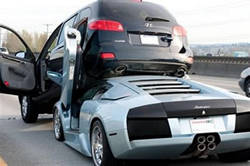
Causes of Rear-End Collisions
Rarely is someone that is rear-ended at fault in a collision. If you're stopped at an intersection and see or hear another car approaching from the rear, you can either:
If there is room ahead of your vehicle, pull forward and/or to the side. This will give the other car more time to avoid or reduce the severity of the impact.
If a crash can't be avoided, release your brake before being hit. The force of the impact will be reduced and directed into moving your vehicle forward.
Vehicle rear-end collisions are among the most common types of motor vehicle accidents in the United States. Rear-end collisions occur when one vehicle strikes the back of another vehicle, often resulting in serious injury or even death. The most common causes of rear-end collisions are driver inattention, following too closely, or speeding.
Rear-end collisions tend to be the most severe when the victim vehicle is at a stop or nearly stopped. This is because the victim vehicle has no time to react and protect itself from the impact. In a rear-end collision, the striking vehicle will typically push the victim vehicle forward, leading to more severe injuries to the occupants.
The most common injuries resulting from rear-end collisions include whiplash, lacerations, broken bones, and head and neck injuries. Whiplash is the most common type of injury resulting from rear-end collisions, and is caused by the sudden jerking motion of the head and neck that occurs during the impact. This type of injury often leads to long-term pain and suffering.
In addition to the physical injuries, rear-end collisions can also lead to property damage and financial losses. Property damage may include damage to the vehicles, as well as any objects that were in or near the vehicles. Financial losses can include medical bills, lost wages, and even legal fees.
In order to reduce the risk of rear-end collisions, drivers should practice safe driving habits. This includes avoiding distractions, always keeping a safe distance between cars, and obeying speed limits. Drivers should also be aware of their surroundings, including watching for vehicles that may be slowing or stopping ahead of them.
If you are involved in a rear-end collision, it is important to seek medical attention and contact a personal injury attorney. An experienced attorney can help you recover compensation for your injuries and other losses. They can also help ensure that the at-fault driver is held responsible for their actions.
Implementing Evasive Maneuvers to Avoid Rear-End Collisions
When you’re driving, you may suddenly find yourself in a situation where you have to take evasive maneuvers to avoid a rear-end collision. This is a dangerous situation and one that requires quick decision-making and precise driving. To help you stay safe on the roads, here are some tips on how to avoid vehicle rear-end collisions.
1. Stay aware of your surroundings. The best way to avoid rear-end collisions is to stay aware of your surroundings at all times. Scan the road ahead of you and look for potential hazards, such as vehicles braking suddenly, pedestrians crossing the street, or other obstacles. This will give you enough time to react and take evasive maneuvers if necessary.
2. Leave enough space between you and the vehicle in front of you. Rear-end collisions typically occur when the vehicle in front of you brakes suddenly and you don’t have enough time to react. To reduce the risk of a collision, leave enough space between your car and the vehicle in front of you so that you have time to react and stop safely.
3. Use your brakes early and gently. If you’re approaching a red light, brake early and gently instead of slamming on the brakes at the last minute. This will give you more time to react and take evasive maneuvers if necessary.
4. Use your horn to alert other drivers. If you’re approaching a vehicle that is braking suddenly, use your horn to alert the other driver. This may help them realize that you’re there and give them the chance to move out of the way.
5. Make sure your brakes are in good condition. If you’ve been driving for a while, make sure that your brakes are in good condition. This will ensure that you’re able to brake quickly and safely if necessary.
6. Don’t tailgate. Tailgating is a common cause of rear-end collisions, so make sure you’re not following too closely behind the vehicle in front of you.
7. Know your vehicle’s stopping distance. Every vehicle has a different stopping distance, so make sure you’re aware of your vehicle’s stopping distance. This will help you know how much time you have to react and take evasive maneuvers.
8. Be aware of the weather. If it’s raining or snowing, make sure you’re aware of the road conditions and take extra caution while driving. Wet roads can make it harder to stop quickly, so make sure you leave even more space between you and the vehicle in front of you.
By following these tips, you can reduce the chances of being involved in a rear-end collision. However, if you do find yourself in a situation where you have to take evasive maneuvers, stay calm and take your time. Make sure you’re aware of your surroundings and that you have enough space to stop safely.
Implementing Necessary Evasive Maneuvers















